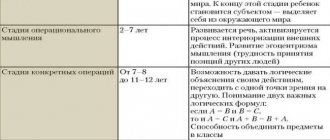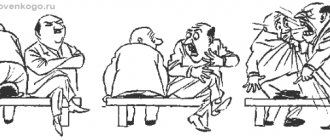Human Temperament - Definition
Temperament
- this is a stable set of individual psychophysical properties of a person associated not with the content, but with the dynamic aspects of activity.
Simply put, temperament refers to a person’s ability to react to external stimuli and move from one reaction to another. Temperament is determined by the type of higher nervous activity, which consists of three components - the “strength” of the nervous system, its “mobility” and “balance”.
Today, the theory of temperaments is only one of many systems that describe the types of human personality. And once upon a time it was the only such system. The doctrine of them was developed by the ancient doctors Hippocrates and Galen, who were confident that a person’s character type depends on the predominance of one or another “vital juice” in his body - blood, lymph, yellow and black bile. And the word “temperament” itself, translated from Latin, means “mixture” - it meant a mixture of these “vital juices”.
Properties of the nervous system and temperament
Temperament does not appear immediately, not completely from birth, but gradually. The human nervous system develops not only in the womb, but also after birth. Thus, the properties of temperament change, but in the first years of a person’s life, which depends on the development of his nervous system.
The fundamental properties influencing nervous activity are excitability and inhibition. Pavlov proposed the following properties that influence the formation of temperament:
- The strength of manifestations is the ability of the psyche to cope with strong stimuli.
- Balance is an indicator of the ratio of excitation and inhibition.
- The mobility of processes is the rate at which excitation and inhibition alternate with each other.
Depending on the manifestations of the processes of the nervous system, they become private (partial) or general. Particular properties appear in specific situations or under certain conditions. General properties form a person’s temperament because they are constant.
Additional properties of the nervous system are:
- Lability is the speed of appearance and progression of excitation and inhibition.
- Dynamism - the speed and ease of formation of reflexes.
- Concentration is the boundary of differentiation of stimuli.
The functioning of the nervous system affects what individual properties an individual will have. At the same time, psychologists note that weaknesses of the nervous system are not negative aspects. It’s just that the nervous system copes better with certain stimuli than with others. And this does not depend on the individual himself. Research is needed here to help find out how weaknesses in nervous activity can be influenced.
Types of temperaments and their characteristics
Ancient scientists thus identified the main types of temperaments, of which there are four:
- A sanguine person
is an energetic, cheerful and sociable, balanced individual. - A choleric person
is an energetic but unbalanced person, subject to fits of rage and anger, who has difficulty controlling his actions. - A phlegmatic person
is a balanced, calm and slow person who scrupulously carries out his duties and is not prone to fuss. - A melancholic person
is an unbalanced and weak person, subject to feelings of fear and sadness.
In principle, this classification of temperament types has not lost its meaning today, however, pure melancholics, cholerics, sanguines and phlegmatics are quite rare. Therefore, it usually makes sense to talk only about a mixed type of temperament.
The classical system is widely in demand in culture - literature, science, art. Of course, modern scientists understand that there is no “predominance of vital juices”, and the type of temperament is determined by an imbalance in the neurochemical system of the body. If the imbalance reaches an extreme degree, then the temperaments flow into the so-called psychiatric profiles, and each of them can develop into a specific mental disorder: choleric people suffer from impulsive personality disorder, sanguine people suffer from hypomania, phlegmatic people suffer from schizoid personality disorder, and melancholic people suffer from anxiety disorder.
The study of temperaments was carried out throughout the twentieth century and continues to this day. Many researchers note that the classical understanding of the type of temperament consists of two components: behavioral activity and emotionality. Based on this, improved classifications were built. And the fact that a person’s temperament depends on the type of higher nervous activity was first proven by the great Russian scientist I. P. Pavlov. He established that higher nervous activity has a similar structure in humans and higher animals. Thus, a certain type of temperament is characteristic not only of humans, but also of the most developed mammals.
There are other theories and classifications that divide personalities according to their properties. One of the most popular classifications is the division of people into extroverts and introverts proposed by Carl Jung. The first unite choleric and sanguine people, and the second - phlegmatic and melancholic. Extroverts are focused on interacting with external stimuli, while introverts are focused on their inner life.
Abstracts For You
INTRODUCTION CHAPTER 1. General concept of temperament CHAPTER 2. Basic properties of temperament CHAPTER 3. Classifications of temperament CHAPTER 4. Psychological characteristics of temperament types CONCLUSION REFERENCES USED
INTRODUCTION
People begin to become familiar with the concept of “temperament” very early. Even in childhood, we notice that some of us are more active, cheerful, persistent, while others are slow, shy, unhurried in words and actions. It is in these features that temperament manifests itself.
The famous psychologist Merlin wrote: “Imagine two rivers - one calm, flat, the other fast, mountainous. The flow of the first is barely noticeable, it smoothly carries its waters, it does not have bright splashes, stormy waterfalls or splashes. The course of the second is the complete opposite. The river rushes quickly, the water in it rumbles, boils and, hitting the stones, turns into shreds of foam... Something similar can be observed in people’s behavior.”
Observations have shown that all people are different not only in appearance, but also in behavior and movements. For example, if you monitor the behavior of students in class, you can immediately notice the difference in the behavior and movements of each one. Some have unhurried, correct movements, a noticeable calmness in their gaze, while others have sudden movements, fussiness in their eyes, but most of them show similar results in development. What explains this difference in behavior? First of all, temperament, which manifests itself in any type of activity (play, work, study, creative), in gait, gestures, in all behavior. The individual characteristics of a person’s personality and his temperament give a unique color to all activities and behavior.
CHAPTER 1. GENERAL CONCEPT OF TEMPERAMENT
When they talk about temperament, they mean many mental differences between people - differences in depth, intensity, stability of emotions, emotional sensitivity, pace, energy of actions and other dynamic, individually stable features of mental life, behavior and activity. Nevertheless, temperament today remains a largely controversial and unresolved problem. However, with all the diversity of approaches to the problem, scientists and practitioners recognize that temperament is the biological foundation on which the personality is formed as a social being.
Temperament reflects the dynamic aspects of behavior, mainly of an innate nature, therefore the properties of temperament are the most stable and constant compared to other mental characteristics of a person. The most specific feature of temperament is that the various properties of a given person’s temperament are not randomly combined with each other, but are naturally connected with each other, forming a certain organization and structure.
So, temperament should be understood as individually unique properties of the psyche that determine the dynamics of a person’s mental activity, which, equally manifested in a variety of activities regardless of its content, goals, motives, remain constant in adulthood and in interconnection characterize the type of temperament.
The properties of temperament include individual characteristics that:
- Regulate the dynamics of mental activity in general;
- Characterize the features of the dynamics of individual mental processes;
- They are stable and permanent in nature and remain in development over a long period of time;
- They are in a strictly natural relationship, characterizing the type of temperament;
- Definitely due to the general type of nervous system.
CHAPTER 2. BASIC PROPERTIES OF TEMPERAMENT
The properties of temperament include those distinctive, individual characteristics of a person that determine the dynamic aspects of all his types of activity, characterize the peculiarities of the course of mental processes, have a more or less stable nature, persist for a long time, appearing soon after birth (after the central nervous system takes on specifically human forms). It is believed that the properties of temperament are determined mainly by the properties of the human nervous system.
Soviet psychophysiologist V.M. Rusalov, relying on a new concept of the properties of the nervous system, proposed on its basis a more modern interpretation of the properties of temperament. Based on the theory of the functional system P.K. Anokhin, which includes four blocks of storage, circulation and processing of information (the block of afferent synthesis, programming (decision making), execution and feedback), Rusalov identified four associated temperament properties that are responsible for the breadth or narrowness of afferent synthesis (the degree of intensity of the body’s interaction with environment), ease of switching from one behavior program to another, speed of execution of the current behavior program and sensitivity to the discrepancy between the real result of an action and its acceptor.
In accordance with this, the traditional psychophysiological assessment of temperament changes and instead of two parameters - activity and sensitivity - it now includes four components: ergicity (endurance), plasticity, speed and emotionality (sensitivity). All these components of temperament, according to V.M. Rusalova, are biologically and genetically determined. Temperament depends on the properties of the nervous system, and they, in turn, are understood as the main characteristics of functional systems that provide integrative, analytical and synthetic activity of the brain and the entire nervous system as a whole.
The psychological characteristics of temperament types are determined by the following basic properties:
Sensitivity - we judge this property by what is the least force of external influences necessary for the occurrence of any psychological reaction in a person, and what is the speed of occurrence of this reaction.
Reactivity - this property is judged by the degree of involuntary reactions to external or internal influences of the same strength.
Activity - this property is judged by the degree of activity with which a person influences the outside world and overcomes obstacles in achieving goals. This includes focus and perseverance in achieving goals, concentration in long-term work.
The ratio of activity and reactivity - this property is judged by the speed of various psychological reactions and processes: speed of movements, rate of speech, resourcefulness, speed of memorization, speed of mind.
Plasticity and rigidity - this property is judged by how easily and flexibly a person adapts to external influences or, conversely, how inert and rigid his behavior, habits, and judgments are.
Extraversion and introversion - this property is judged by what primarily determines a person’s reactions and activities - from external impressions arising at the moment (extroversion) or from images, ideas and thoughts associated with the past and future (introversion).
Emotional excitability - this property is judged by how weak an impact is necessary for the occurrence of an emotional reaction and at what speed it occurs.
CHAPTER 3. CLASSIFICATIONS OF TEMPERAMENT
Different classifications of temperaments rely on their different properties:
1) speed and strength of emotional reactions;
2) level of activity and predominant feeling tone;
3) scales of extraversion (introversion) and neuroticism (emotional stability);
4) reactivity and activity;
5) general mental activity, historian and emotionality.
The similarity noticeable in these classifications shows that the identified psychological characteristics really form a special, fairly clearly defined group of individual properties.
In these examples of classifications, only the most general properties are noted. A more complete list of such properties, including more specific ones, is as follows: sensitivity, reactivity and activity, rate of reactions, plasticity and rigidity, extroversion and introversion, emotional excitability.
According to the teachings of the ancient Greek physician Hippocrates (VI century BC), there are four types of temperament. The body was believed to have four main fluids, or "juices": blood, phlegm, yellow bile, and black bile. Mixed in certain proportions, they make up his temperament. The specific name of the types of temperament was given by the fluid predominant in the body: melancholic, sanguine, phlegmatic and choleric temperament (hence melancholic; sanguine; phlegmatic; choleric).
Psychological teaching about temperament. The approach to temperament characteristic of this teaching is to proceed from the analysis of only behavior. When determining temperament, as a rule, the sign of innate or organic foundations does not appear, and the main load is on the sign of “formal-dynamic properties of behavior,” which are abstracted from holistic behavioral acts. But here a significant difficulty is revealed: this feature also does not allow us to unambiguously resolve the issue of the range of specific properties that should be attributed to temperament. And the tendency to expand the range of such properties leads to a confusion of temperament with character and even personality.
Physiological doctrine of temperament. Throughout the long and complex history of the study of temperament, it has always been associated with the physiological characteristics of the body. One of the most serious attempts to provide a physiological basis for temperament is associated with the names of I. P. Pavlov, B. M. Teplov and Nebylitsyn. Initially, this concept was called the doctrine of the types of the nervous system, later - the doctrine of the properties of the nervous system.
Regardless of the listed hypotheses about the physical foundations of temperament, there is a growing conviction that its properties are most clearly manifested in those forms of behavior that are directly related to the energy expenditure of the body - with the methods of accumulation and expenditure of energy and the quantitative characteristics of processes. Therefore, most temperament researchers paid attention, first of all, to the emotional and motor reactions of the individual, especially emphasizing their formal aspect, that is, their strength (intensity) and course over time.
A classic example of this approach is the typology of temperaments by W. Wundt, the creator of experimental psychology. He understood temperament as a predisposition to affect, which was expressed in the following thesis: temperament is for emotion what excitability is for sensations. Based on this understanding, W. Wundt identified two bipolar properties of temperament, namely the strength and speed of change of emotion, emphasizing the importance of the individual’s energy characteristics.
Classification of temperaments (according to Wundt)
| Speed of change of feelings | Strength of feelings | |
| strong | weak | |
| fast | choleric | sanguine |
| slow | melancholic | phlegmatic person |
We find in W. Wundt an extremely important idea that each temperament has its positive and negative sides, and this, in particular, means that proper education involves using the advantages of a given temperament and at the same time leveling out the negative influence that it may have influence an individual's behavior.
There remains confidence that the dynamic properties of behavior manifested in temperament have a physiological basis - certain features of the functioning of physiological structures. The question of what these structures and features are is being intensively researched. There are different opinions about what specific characteristics of the body should be associated with temperament - hereditary or simply physiological, which can be formed during life. There is a fundamental difficulty here: it has not yet been established what, in terms of behavior, is a manifestation of the genotype (refers to temperament), and what is the result of lifetime layers (refers to character).
CHAPTER 4. PSYCHOLOGICAL CHARACTERISTICS OF TYPES OF TEMPERAMENT
The ancient Greek physician Hippocrates, who lived in the 5th century BC, described four temperaments, which were given the following names: sanguine temperament, phlegmatic temperament, choleric temperament, melancholic temperament. He described the main types of temperaments, gave them characteristics, but connected temperament not with the properties of the nervous system, but with the ratio of various fluids in the body: blood, lymph and bile. The first classification of temperaments was proposed by Galen, and it has survived to this day in a relatively little changed form. The last known description of it, which is also used in modern psychology, belongs to the German philosopher I. Kant.
I. Kant divided human temperaments (manifestations of temperament can also be seen in higher animals) into two types: temperaments of feeling and temperaments of activity.
According to I.P. Pavlov, temperaments are the “main features” of a person’s individual characteristics.
Below is a psychological description of the four types of temperaments:
Sanguine temperament.
A sanguine person quickly gets along with people, is cheerful, easily switches from one type of activity to another, but does not like monotonous work. He easily controls his emotions, quickly gets used to a new environment, and actively comes into contact with people. His speech is loud, fast, distinct and is accompanied by expressive facial expressions and gestures. But this temperament is characterized by some duality. If stimuli change quickly, novelty and interest of impressions are maintained all the time, a state of active excitement is created in a sanguine person, and he manifests himself as an active, active, energetic person. If the influences are long-lasting and monotonous, then they do not maintain a state of activity, excitement, and the sanguine person loses interest in the matter, he develops indifference, boredom, and lethargy.
A sanguine person quickly develops feelings of joy, grief, affection and hostility, but all these manifestations of his feelings are unstable, do not differ in duration and depth. They arise quickly and can disappear just as quickly or even be replaced by the opposite. The mood of a sanguine person changes quickly, but, as a rule, a good mood prevails.
Phlegmatic temperament.
A person of this temperament is slow, calm, unhurried, and balanced. In his activities he demonstrates thoroughness, thoughtfulness, and perseverance. As a rule, he finishes what he starts. All mental processes in a phlegmatic person seem to proceed slowly. The feelings of a phlegmatic person are poorly expressed outwardly; they are usually inexpressive. The reason for this is the balance and weak mobility of nervous processes. In relationships with people, a phlegmatic person is always even-tempered, calm, moderately sociable, and has a stable mood. The calmness of a person of phlegmatic temperament is also manifested in his attitude towards events and phenomena in life, a phlegmatic person is not easily enraged and emotionally hurt. It is easy for a person of phlegmatic temperament to develop self-control, composure, and calmness. But a phlegmatic person should develop the qualities he lacks - greater mobility, activity, and not allow him to show indifference to activity, lethargy, inertia, which can very easily form under certain conditions. Sometimes a person of this temperament may develop an indifferent attitude towards work, towards life around him, towards people and even towards himself.
Choleric temperament.
People of this temperament are fast, excessively mobile, unbalanced, excitable, all mental processes occur quickly and intensely in them. The predominance of excitation over inhibition, characteristic of this type of nervous activity, is clearly manifested in the incontinence, impetuosity, hot temper, and irritability of the choleric person. Hence the expressive facial expressions, hasty speech, sharp gestures, unrestrained movements. The feelings of a person with choleric temperament are strong, usually clearly manifested, and arise quickly; the mood sometimes changes dramatically. The imbalance characteristic of a choleric person is clearly associated with his activities: he gets down to business with increasing intensity and even passion, showing impetuosity and speed of movements, working with enthusiasm, overcoming difficulties. But in a person with a choleric temperament, the supply of nervous energy can quickly be depleted in the process of work, and then a sharp decline in activity may occur: elation and inspiration disappear, and the mood drops sharply. In communicating with people, a choleric person admits harshness, irritability, and emotional incontinence, which often does not give him the opportunity to objectively evaluate people’s actions, and on this basis he creates conflict situations in the team. Excessive straightforwardness, hot temper, harshness, and intolerance sometimes make it difficult and unpleasant to be in a group of such people.
Melancholic temperament.
Melancholic people have slow mental processes, they have difficulty reacting to strong stimuli; Prolonged and strong stress causes people of this temperament to slow down their activity and then stop it. Melancholic people are usually passive in their work, often with little interest (after all, interest is always associated with strong nervous tension). Feelings and emotional states in people of melancholic temperament arise slowly, but are distinguished by depth, great strength and duration; melancholic people are easily vulnerable, have a hard time withstanding insults and grief, although outwardly all these experiences are poorly expressed in them. Representatives of a melancholic temperament are prone to isolation and loneliness, avoid communicating with unfamiliar, new people, are often embarrassed, and show great awkwardness in a new environment. Everything new and unusual causes melancholics to become inhibited. But in a familiar and calm environment, people with this temperament feel calm and work very productively. It is easy for melancholic people to develop and improve their characteristic depth and stability of feelings, increased susceptibility to external influences.
“Pure” temperaments are relatively rare. There are transitional, mixed, intermediate types of temperament; Often a person's temperament combines traits of different temperaments.
CONCLUSION
Features of the type of higher nervous activity and the properties of temperament have long attracted the attention of researchers. However, the data they obtained is extremely contradictory. Many theories and study methods have been put forward.
Beginning in the mid-18th century, theories of temperament related to certain properties of the nervous system developed. Thus, Albrecht Haller, the founder of experimental physiology, who introduced the concepts of excitability and sensitivity, which are important for psychology, argued that the main factors for differences in temperament are the strength and excitability of the blood vessels themselves through which blood passes. This idea was adopted by A. Haller’s student, G. Wrisberg, who connected temperament directly with the characteristics of the nervous system. Thus, he believed that the choleric sanguine temperament was based on a large brain, “strong and thick nerves” and high excitability of the senses. The idea of connecting the characteristics of temperament with certain anatomical and physiological characteristics of the nervous system in various forms is manifested in the teachings of many philosophers and doctors of the 18th and 19th centuries. The idea of the existence of such a connection was expressed by I.P. Pavlov, who assumed that the extreme human types of “thinkers” and “artists” should also correspond to the opposite types of temperaments, melancholic and choleric. He established and experimentally proved that the physiological basis of temperament is a combination of the properties of nervous processes. B.M. Teplov, rejecting Pavlov’s scheme of “four classical temperaments,” proposed considering all combinations of properties of the nervous system as independent types, posing as a special task the question of the criteria on the basis of which “main types” can be distinguished from them.
LIST OF REFERENCES USED
- Maklakov A.G. General psychology. - St. Petersburg, 2000.
- Merlin V.S. Essay on the theory of temperament. - M., 1964.
- Nebylitsyn V.D. Basic properties of the human nervous system // Izbr. psychological works. - M., 1990.
- Petrovsky A.V. Introduction to Psychology. - M., 1995.
- Rogov E.I. General psychology: A course of lectures for the first stage of teacher education. - M., 1998.
- Strelyau Ya. The role of temperament in mental development. - M., 1982.
Was it useful to you? Tell your friends!
I like
Properties of temperament
As you can guess from the above, temperament is a “composite” characteristic. The introduction of this concept into science was an attempt to describe the entire personality of a person - in the understanding that was developed in the ancient era. Over many centuries, it has been established that the human personality has many more properties and “facets”, so the theory of temperaments may not be completely outdated, but it needs serious improvement.
The increased interest in temperament in the modern world is associated, in particular, with the development of the very concept of “personality”. This has a certain connection with changes in socio-political life, the struggle for civil rights, social policy and other phenomena and processes, the center of which is the person as an individual.
The recognition of “personality” in a person happened not so long ago, and in the old days no one thought about it. Thus, in ancient times and in the Middle Ages, the description of a person was limited to the estate, caste or class system, age and gender, and no special attention was paid to individual character traits. This was especially characteristic of Russian culture, in which interest in the human personality arises much later than in European countries. The works of Russian authors of the early 18th century are replete with foreign words (“bisaria”, “humor”, etc.), denoting concepts that seem elementary today: “character”, “inclination”, “impression” and others. And even many Russian and Soviet writers of the first half of the twentieth century refused to recognize the word “mood,” calling it “an unsuccessful invention of decadents.” The opponent of this word was, in particular, Korney Chukovsky. However, time passed, and the need to understand the subtle features of an individual’s behavior and emotional life was felt by everyone - ordinary people interested in building relationships with others, politicians, criminologists, and doctors.
In this regard, it is important to understand the properties of temperament. And they determine a lot: at what speed a person can think, act, do work, how well he remembers information, how happy, sad, angry he is, how quickly he can change his mood. Temperament can significantly influence a person’s career and self-realization. At the same time, however, a person with a certain temperament is not necessarily smarter or stupider in relation to a person with a different temperament, and, for example, a more well-read, quick-witted and inventive phlegmatic person may be less successful in scientific research than his slightly less developed one, but a more active and sociable sanguine colleague.
Temperament even affects a person's handwriting. A more active individual’s handwriting is taller, wider and more sweeping, the distance between the letters is quite large, while a less active individual’s handwriting is lower, narrow and “compressed”, the letters are as close to each other as possible. At the same time, a person with a higher activity has a more difficult time mastering small details of letters and signs, while a person with a lower activity can master small details, but not large ones.
The nature of human activity is also manifested in communication. The more active person’s speech is loud, bright and rich, faster, with well-defined gestures, facial expressions, and intonations. An inactive person shows much less expressiveness in speech; such speech can be abrupt, monotonous, and the face creates the impression of a “stony” face.
At the same time, positive words and images predominate among sanguine and phlegmatic people, while choleric and melancholic people often have more negative ones. Sanguine and choleric people are the first to make contact, they show a keen interest in communication, they want to share their thoughts and feelings with others. On the contrary, phlegmatic and melancholic people prefer solitude and are not often the first to start a conversation, but they are the first to willingly end the conversation. “Slow-tempered” (melancholic, phlegmatic) have difficulty switching from one topic to another and from one person to another, while “excitable” (choleric and sanguine) are ready to talk about everything and with everyone at once. Phlegmatic people and melancholic people may therefore seem annoying; they can harp on the same topic for hours.
People of different types have different attitudes towards interpersonal connections and friendship. Sanguine people love to make as many friends and acquaintances as possible and know how to attract them to themselves; Choleric people also tend to have a large number of acquaintances, but their behavior can repel others. Phlegmatic people form close relationships with a small number of people, but these relationships are usually strong and long-lasting; melancholic people can also be attached to a small number of friends and acquaintances, but often the connections quickly collapse.
Characteristics of temperament should be taken into account when choosing a profession and type of activity, even a specific organization. For example, professional sports are “tailored” for sanguine people and especially choleric people, and people with a slow pace of activity are not suitable for this area, unless it is chess. But even in “mind sports”, the ability to think quickly and react quickly, quickly assess your position, make moves and not lose your temper in case of a mistake is often required; In professional competitions, as is known, the running time is limited. An important problem in chess and other intellectual games is time pressure - lack of time to think about moves. Apparently, taking into account the interest in such games mainly among phlegmatic people, the eleventh world chess champion Robert Fischer proposed the idea of “soft” time pressure, in which a little more time is added to the player after each move; Even a special watch design is used for this purpose. Currently, “soft” time pressure is widely used in chess and other board games.
However, research has established that temperamental characteristics have virtually no effect on the performance of a person in an environment that can be described as normal. Both excitable and inhibited workers show the same results and do the same work if, simply put, they are not distracted by anything - extraneous noise, lack of time, too many or few employees in the room, poor temperature conditions, and so on. But the fact is that it is very difficult to create absolutely normal conditions for work, and then the peculiarities of temperament come into force.
How do people with different personality characteristics work?
Choleric people have a very high performance capacity, but they tend to get carried away too much, which is why they waste their energy. Sanguine people also have a tremendous capacity for work, but they realize it only if they like the work; if they don’t like it, they begin to be indifferent to their work and get bored. Phlegmatic people work slowly, but are distinguished by equanimity, calmness and perseverance, thanks to which they perform their work conscientiously. Melancholic people tend to react sharply to external stimuli; they are absorbed in their internal experiences; They can conscientiously fulfill their duties only in the most calm and positive environment in the presence of any positive impressions.
The famous Soviet psychologist B. M. Teplov established that workers with different temperaments differ not in the final results of their activities, but in the ways of achieving these results. That is, the individual style of activity of a particular employee primarily depends on a specific temperament. Knowing this allows you to organize the work of the organization in such a way as to get maximum performance from each employee.
For example, for melancholic people you can set a flexible schedule, you can put them in a room with a minimum amount of irritating factors; Phlegmatic people should not be required to complete work within a strictly established time frame, especially a short one; instead, it is better to focus on the quality of the product. Sanguine people need to be interested in work by creating conditions in which they can demonstrate their abilities and demonstrate their skills to others.
Temperament is a set of innate human properties. And when they say that these innate, initially inherent properties influence the behavior, work of a person and his activity in general, then this can cause bewilderment among the unprepared: after all, it is known that a person is a teachable being, and he learns everything throughout his life. Indeed, a person learns many things, but the limits of learning are still influenced by the innate properties of the individual.
The standard of the educational process is the school, and it is enough to look at any school class to identify conscientious and immersed in study phlegmatic people (often they are “nerds”), and choleric people who skip classes for the sake of sports achievements, and those who attract everyone’s attention, artistic sanguine people, and melancholic people. who are often “difficult teenagers” and also experience learning difficulties due to their nature. Of course, one cannot say that a phlegmatic person will necessarily be an excellent student, and the destiny of a melancholic person is correctional education, but for success in educational activities, each student needs an individual approach, and not every school can provide this.
Among the outstanding people were representatives of all temperaments and their combinations. Thus, Pyotr Ilyich Tchaikovsky was described as a typical melancholic person. Yesenin, Chekhov, Gogol, Chopin were the same. Beethoven, Pushkin, and Byron were choleric. Typical phlegmatic people are Ivan Krylov, Kutuzov, Galileo, Kant. Sanguine people - Mozart, Prokofiev, Balzac, V.I. Lenin.
Representatives of all types can be found among modern politicians. Gennady Zyuganov is a phlegmatic person, Grigory Yavlinsky is a melancholic person, Bill Clinton is a sanguine person, and Vladimir Zhirinovsky is a pronounced choleric person. As we see, in any profession there are “excitable” and “inhibited” representatives, although some types of activities are more suitable for one or another personality type: for example, among politicians, a larger percentage of truly outstanding personalities are observed among choleric and sanguine people - these are severe dictators, great reformers, revolutionaries, prominent political figures, brawlers. Among phlegmatic people, the majority are mathematicians, physicists, chemists, and philosophers; even the composer Alexander Borodin, a famous phlegmatic, was no less an outstanding chemist. Among the melancholic people, the most outstanding were, of course, poets, writers, composers, and artists.
The friendship of two great composers – Chopin and Liszt – became widely known. The first was a melancholic personality, and the second was a typical choleric person. This, however, did not interfere with their friendship, and even vice versa - the qualities of one complemented what was missing in the other. The nature of the music and the style of performance itself was significantly different for both composers. Chopin could not play in large halls; he preferred small aristocratic rooms. Liszt, on the contrary, loved performing in huge halls, and the more people there were at the concert, the more inspired he was. Contemporaries wrote that at the end of the concert, Liszt stood in the middle of the hall as a winner among defeated enemies. They say that at one of the dinner parties Liszt played one of Chopin’s works, and in his own manner. Chopin, who was present there, did not like this performance; however, when his friend played another of his etudes, even Chopin himself was delighted.
Definition of basic temperaments in psychology
Choleric
Choleric people are overly mobile, fast, excitable, unbalanced , all their psychological processes are intense and fast. The predominance of excitation over inhibition characteristic of this type of nervous activity is expressed in the impetuousness, lack of restraint, irritability, and hot temper of the choleric person. This results in hasty speech, expressive facial expressions, unrestrained movements, and sharp gestures.
The feelings of a choleric person are strong, as a rule, they arise instantly and are clearly manifested; the mood sometimes changes dramatically. The imbalance that is characteristic of a choleric person is clearly associated with his work: he enthusiastically and even passionately gets to work, while showing speed of movement and impetuosity, overcoming difficulties, working with enthusiasm.
But a choleric person can quickly deplete his supply of nervous energy during work, and in this case a sharp decline in work may occur: the mood drops sharply, inspiration and elation disappear. When communicating with others, a choleric person allows emotional incontinence, irritability, and harshness; this often does not allow him to objectively evaluate people’s actions, because of this, he creates conflict situations . Excessive temper, straightforwardness, intolerance, and harshness sometimes make being in a group of these people unpleasant and difficult.
Sanguine
A sanguine person easily moves from one type of activity to another, is cheerful, and quickly gets along with people. A sanguine person quickly gets accustomed to a new environment and easily controls emotions. His speech is clear, fast, loud and accompanied by expressive gestures and facial expressions. However, this temperament is characterized by a certain duality . When stimuli change quickly, the interest of impressions and novelty are constantly maintained, then this person manifests himself as energetic, active, active, that is, a state of active excitement is created.
When the effects are monotonous and prolonged, they do not support excitement, a state of activity, and the sanguine person loses interest in the matter, this person develops lethargy, boredom, and indifference. A sanguine person quickly develops feelings of grief, joy, hostility or affection, but all such manifestations of his feelings are not distinguished by depth, duration and stability. They appear quickly and can also quickly disappear or even change to the opposite. A sanguine person's mood changes quickly , but most often there is a good mood.
Melancholic
Psychological processes in these people go through slowly, they react with difficulty to powerful stimuli; strong and prolonged overexertion in these people causes slow activity, and then its cessation. Melancholic people are usually passive at work and often have little interest. Emotional states and feelings in melancholic people appear slowly, but are characterized by duration, great strength and depth. These people have a hard time withstanding grief and resentment, and are easily vulnerable, although outwardly all these experiences are not expressed.
Melancholic people avoid communicating with new and unfamiliar people, are prone to loneliness and isolation , show awkwardness in new surroundings, and are often embarrassed. Everything unusual and new causes a state of inhibition in melancholic people. But in a calm and familiar environment, these people work quite productively and feel calm.
Phlegmatic person
A phlegmatic person is calm, slow, balanced, unhurried. In his work he shows perseverance, thoughtfulness, and thoroughness. Most often, he brings any task to the end. All psychological processes in this person seem to be slow. His feelings are expressed outwardly weakly, as a rule, they are inexpressive. A phlegmatic person in relationships with people is always moderately sociable, calm, even, and has a stable mood.
It is difficult to touch a phlegmatic person emotionally and make them angry. It is easy for him to develop calmness, composure, and restraint . However, a phlegmatic person needs to develop the qualities he lacks - activity, greater mobility, to avoid indifference to work, inertia, lethargy, which are easily formed in certain conditions.
Differences between temperament and character
Temperament is the foundation for a larger characteristic of the human personality - character. Sometimes these concepts are not distinguished and confused, although, in a strict sense, they are not the same thing. It was said above about acquired skills, habits, character traits and their difference from innate ones. So, character is precisely the acquired mental properties, although formed under the influence of innate qualities.
The character of representatives of different temperaments may be the same, but it manifests itself in different ways. Thus, phlegmatic people and sanguine people can be equally sociable, but the external manifestation of this sociability will be significantly different. Some specific innate qualities can predetermine the development of some character traits and counteract the emergence of others. It also happens that the development of certain character traits allows a person to restrain negative and currently undesirable innate properties; this phenomenon lies, in particular, at the basis of willpower.
Knowledge about the dependence of innate and acquired qualities allows you to find an individual approach to raising children. A child with any personality type (melancholic, choleric, sanguine or phlegmatic) can develop any character traits, but the methods of education must be different.
Let's return to outstanding personalities. Mikhail Illarionovich Kutuzov was a phlegmatic person by nature, but the corresponding innate mental properties alone could not have made him a famous commander - a choleric person would have been more useful here. Education, training and self-improvement made Kutuzov the way he went down in history.
Isaac Newton seems to us a pronounced phlegmatic person, but his contemporaries described him as a typical melancholic person. Russian Emperor Nicholas I was also melancholic, famous for his harsh “stick” regime of government, military discipline and ruthless fight against corruption - that is, all that, in theory, should reveal a choleric person in him.
In general, character is something that needs training, development and hardening. As a result, even a person with weak innate abilities can show strength of character. This is often observed in emergency situations - for example, during war.











